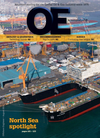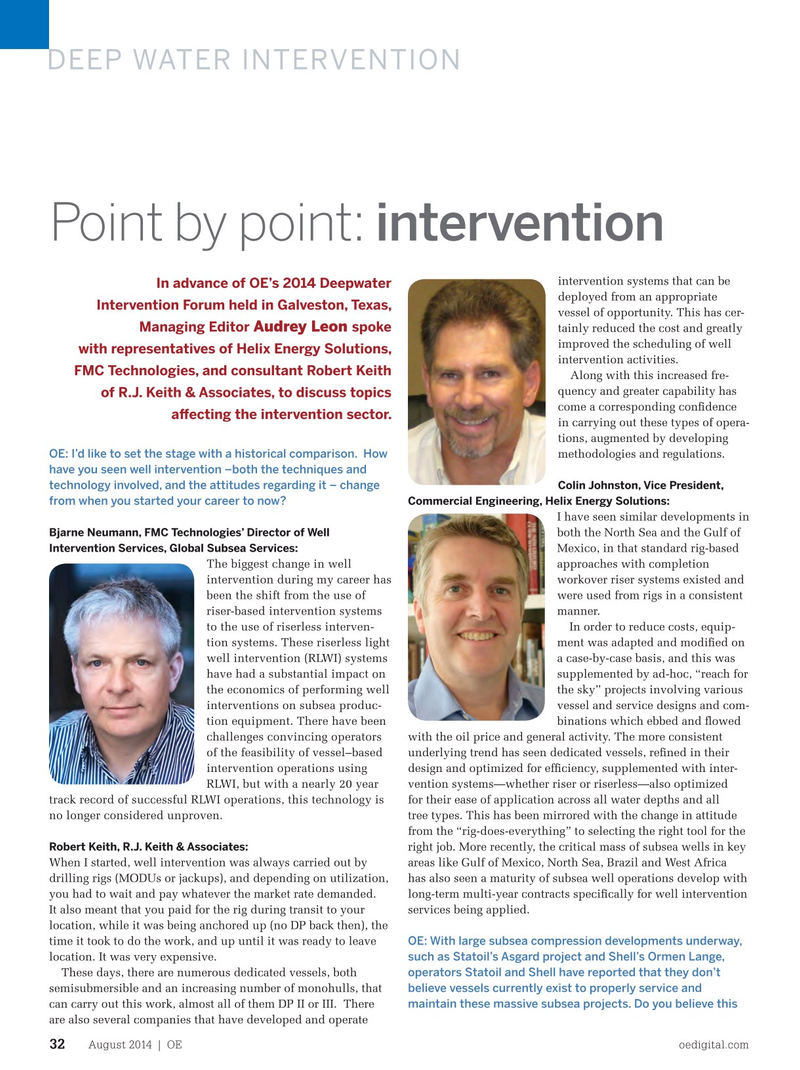
Page 30: of Offshore Engineer Magazine (Aug/Sep 2014)
Read this page in Pdf, Flash or Html5 edition of Aug/Sep 2014 Offshore Engineer Magazine
DEEP WATER INTERVENTION
Point by point: intervention intervention systems that can be
In advance of OE’s 2014 Deepwater deployed from an appropriate
Intervention Forum held in Galveston, Texas, vessel of opportunity. This has cer-
Managing Editor spokeAudrey Leon tainly reduced the cost and greatly improved the scheduling of well with representatives of Helix Energy Solutions, intervention activities.
FMC Technologies, and consultant Robert Keith
Along with this increased fre- quency and greater capability has of R.J. Keith & Associates, to discuss topics come a corresponding confdence afecting the intervention sector.
in carrying out these types of opera- tions, augmented by developing
OE: I’d like to set the stage with a historical comparison. How methodologies and regulations.
have you seen well intervention –both the techniques and
Colin Johnston, Vice President, technology involved, and the attitudes regarding it – change
Commercial Engineering, Helix Energy Solutions: from when you started your career to now?
I have seen similar developments in
Bjarne Neumann, FMC Technologies’ Director of Well both the North Sea and the Gulf of
Intervention Services, Global Subsea Services:
Mexico, in that standard rig-based
The biggest change in well approaches with completion intervention during my career has workover riser systems existed and been the shift from the use of were used from rigs in a consistent riser-based intervention systems manner. to the use of riserless interven- In order to reduce costs, equip- tion systems. These riserless light ment was adapted and modifed on well intervention (RLWI) systems a case-by-case basis, and this was have had a substantial impact on supplemented by ad-hoc, “reach for the economics of performing well the sky” projects involving various interventions on subsea produc- vessel and service designs and com- tion equipment. There have been binations which ebbed and fowed challenges convincing operators with the oil price and general activity. The more consistent of the feasibility of vessel–based underlying trend has seen dedicated vessels, refned in their intervention operations using design and optimized for effciency, supplemented with inter-
RLWI, but with a nearly 20 year vention systems—whether riser or riserless—also optimized track record of successful RLWI operations, this technology is for their ease of application across all water depths and all no longer considered unproven. tree types. This has been mirrored with the change in attitude from the “rig-does-everything” to selecting the right tool for the
Robert Keith, R.J. Keith & Associates: right job. More recently, the critical mass of subsea wells in key
When I started, well intervention was always carried out by areas like Gulf of Mexico, North Sea, Brazil and West Africa drilling rigs (MODUs or jackups), and depending on utilization, has also seen a maturity of subsea well operations develop with you had to wait and pay whatever the market rate demanded. long-term multi-year contracts specifcally for well intervention
It also meant that you paid for the rig during transit to your services being applied.
location, while it was being anchored up (no DP back then), the time it took to do the work, and up until it was ready to leave OE: With large subsea compression developments underway, location. It was very expensive. such as Statoil’s Asgard project and Shell’s Ormen Lange,
These days, there are numerous dedicated vessels, both operators Statoil and Shell have reported that they don’t semisubmersible and an increasing number of monohulls, that believe vessels currently exist to properly service and can carry out this work, almost all of them DP II or III. There maintain these massive subsea projects. Do you believe this are also several companies that have developed and operate
August 2014 | OE oedigital.com 32 032_OE0814_DWI1_DIF roundtable.indd 32 7/22/14 9:07 PM

 29
29

 31
31